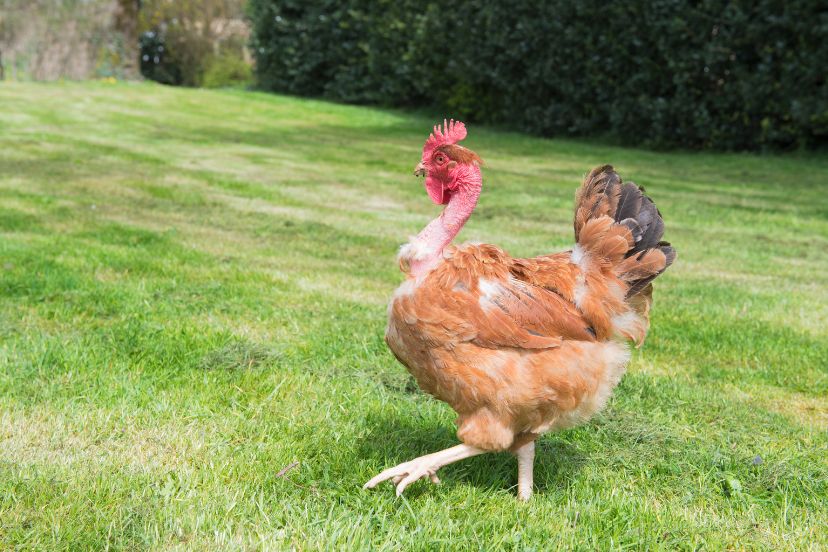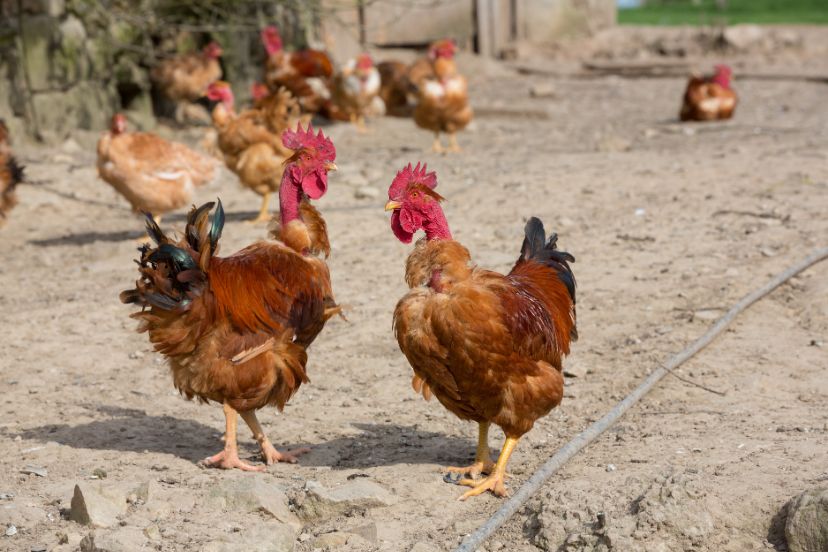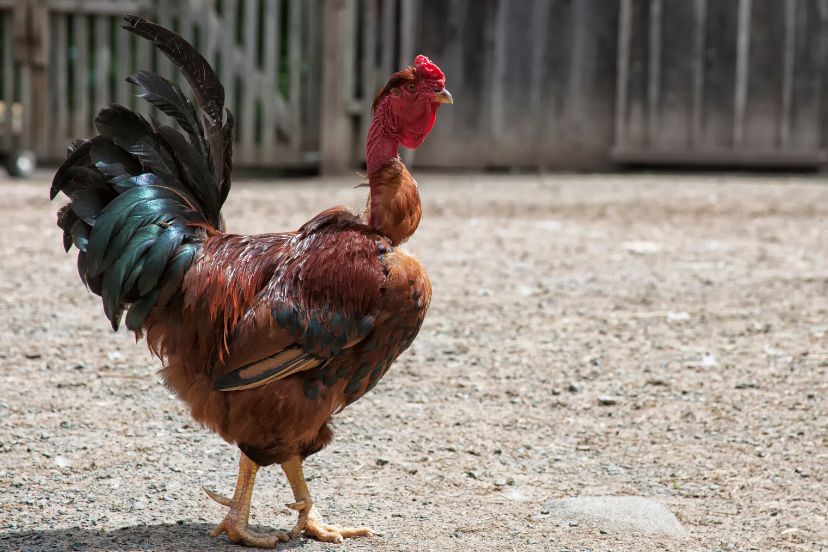Naked Neck Chickens: Benefits, Care, and More
Naked Neck Chickens, or Turken Chickens, are a unique breed known for their bare necks. Unlike other chickens, the Naked Neck Chickens have no feathers on their neck, giving them a rather odd yet charming appearance. Now, you might be wondering, why would anyone choose such a chicken? Let’s find out!
| Read Next: |
California White Chickens: The Feathered Wonder of the West
Why Choose Naked Neck Chickens?
Naked Neck Chickens, often garnering a second glance due to their distinct featherless necks, have more to offer than just a unique aesthetic. They’re a breed that goes beyond the surface, and if you’re pondering on the idea of raising them, here are some compelling reasons why they might just be the perfect choice for you:
Adaptability to Diverse Climates: One of the significant advantages of Naked Neck Chickens is their adaptability to different weather conditions, especially hot climates. The absence of feathers on their neck means that they have fewer feathers to trap heat, allowing them to remain cool. This feature is especially useful in regions that experience scorching summers.
Economical to Maintain: If you’re into poultry farming with an eye on expenses, then the Naked Neck Chickens have got your back! These birds tend to consume less feed compared to other breeds, making them a cost-effective choice in the long run.
Versatile Utility: Whether you’re raising them for meat, eggs, or both, Naked Neck Chickens won’t disappoint. They have a decent meat yield and lay a good number of eggs, making them versatile for different poultry purposes.
Friendly and Calm Temperament: For those new to poultry farming or even for families looking to keep them in their backyard, the docile nature of Naked Neck Chickens is a blessing. They get along well with other chickens and are quite approachable, making them a joy to care for.
Disease Resistance: Another feather in their cap (pun intended) is their commendable resistance to common poultry ailments. This not only ensures that you have fewer trips to the vet but also that you’re investing in a breed that is resilient and hearty.
A Conversation Starter: Let’s face it – the unique look of these chickens can be a great conversation starter! Whether it’s friends, neighbors, or fellow poultry enthusiasts, their distinctive appearance is bound to spark interest and curiosity.
Characteristics of Naked Neck Chickens
Naked Neck Chickens, also fondly called Turkens, are fascinating, both in terms of appearance and other intrinsic qualities. Here’s a more detailed dive into their notable characteristics, which sets them apart from the common poultry breeds:
Feathering
The feathering—or rather, the lack thereof—of the Naked Neck Chickens is undeniably their most recognizable feature.
Unlike other breeds, a significant portion of their neck remains featherless. This bare patch, extending from the base of their beak down to their chest, starkly contrasts the rest of their feathered body, creating a unique and sometimes exotic appearance.
This featherless trait isn’t just for show. In fact, it provides these chickens with a natural cooling system. With fewer feathers trapping heat, they can regulate their body temperature more efficiently in warmer climates. This physiological feature offers a practical advantage, especially for poultry enthusiasts in hot regions.
Beyond their bare necks, the feathering on the rest of their bodies can come in various colors. Whether it’s black, white, or a mix, these chickens certainly aren’t monochromatic and can add a splash of color to your coop.
Size and Weight
When considering poultry for various purposes, their size and weight play a crucial role.
On average, adult Naked Neck roosters weigh between 6 to 8 pounds, while the hens, being slightly petite, weigh around 4 to 6 pounds. This weight range categorizes them as medium-sized chickens.
Their substantial size, especially in roosters, makes them an excellent choice for meat. The meat is tender and flavorful, making it a favorite among many poultry enthusiasts. Additionally, their larger breast portion offers a generous yield.
For those with limited space or those dabbling in backyard poultry farming, their size strikes a balance. They’re not too large to require extensive space, yet they’re big enough to be purposeful for both egg and meat production.

Whether you’re looking at them for their meat, their adaptability to different climates, or simply for their curious looks, these chickens have characteristics that are both intriguing and beneficial.
Behavior and Temperament
When choosing a breed for poultry farming or even for backyard companionship, understanding the behavior and temperament is as essential as knowing about their physical characteristics. Let’s delve deeper into what makes the Naked Neck Chickens stand out in terms of their demeanor.
One of the first things you’ll notice about the Naked Neck Chickens is their gentle disposition. Unlike some poultry breeds that can be aggressive or overly skittish, these chickens exhibit a natural calmness. This temperament is especially endearing as it reduces the chances of conflicts within the flock and ensures a harmonious environment.
Naked Neck Chickens are not just gentle among their own kind; they’re also notably friendly towards humans. Whether you’re feeding them, tending to their coop, or simply spending leisure time in your backyard, these chickens often exhibit curiosity without any trace of aggression. This trait makes them fantastic for families, especially ones with children, as there’s a reduced risk of pecking or chasing.

If you’re considering a mixed breed flock, these chickens generally coexist peacefully with other breeds, ensuring a cohesive and stress-free environment.
Whether it’s for health checks, grooming, or relocation, these chickens tolerate handling quite well. Their docile nature ensures they remain calm even when lifted or inspected. Another boon is their adaptability. Whether you have a sprawling farm or a compact urban backyard, Naked Neck Chickens adjust comfortably, showing no major signs of stress or discomfort.
The forgiving and easy-going nature of the Naked Neck Chickens makes them ideal for first-time poultry keepers. When you’re just getting the hang of things—be it feeding, housing, or general care—having a breed that’s not too demanding can make the learning curve less steep. With their friendly disposition, they can serve as the perfect introduction to the joys and challenges of poultry farming.
Egg Laying Capabilities
Naked Neck Chickens, beyond their distinct appearance and affable nature, are consistent performers when it comes to egg production. On average, a healthy Naked Neck hen lays about 3-4 eggs weekly, culminating in an impressive annual yield of around 150 to 200 eggs. These eggs are typically medium-sized with a natural brown hue, ranging from a light tan to a richer shade, making them not only visually appealing but also versatile for various culinary uses.
Several factors play into optimizing this consistent egg yield. A balanced diet enriched with protein, calcium, and essential vitamins ensures the hens remain in prime laying condition. Furthermore, a comfortable, stress-free environment with suitable nesting boxes coupled with regular health checks and preventive care significantly bolsters their egg-laying prowess.
Discover why chickens produce Double Yolk Eggs.
Benefits of Raising Naked Neck Chickens
Heat Resistance
Naked Neck Chickens are naturally designed to handle heat better than many other breeds, thanks to their featherless neck. This absence of feathers acts as a cooling mechanism, allowing them to dissipate heat efficiently. Especially for regions with predominantly hot climates, these chickens are an excellent fit, reducing the worry of heat stress and the need for additional cooling solutions in their housing.

Disease Resistance
These chickens come with a health advantage: they’re notably resistant to some common poultry diseases. This resilience stems from their robust immune system and genetic makeup, making them particularly appealing for poultry beginners. With Naked Neck Chickens, first-time poultry keepers can experience a smoother initiation into the world of chicken raising, given this breed’s lower susceptibility to certain ailments.
Low Feed Requirements
Economical and efficient, Naked Neck Chickens stand out with their ability to thrive on less feed compared to other breeds. Their impressive feed conversion rate means they can produce meat or eggs while consuming a smaller amount of food. This not only leads to a reduction in feeding costs but also makes them an environmentally friendly choice, minimizing waste and resource use.
How to Raise Naked Neck Chickens
Successfully raising Naked Neck Chickens, like any other breed, hinges on a trifecta of care: appropriate housing, feeding, and healthcare. By ensuring these elements, you can nurture a healthy and productive flock.
Housing
The housing or coop for Naked Neck Chickens serves as their sanctuary. Every chicken, regardless of breed, requires enough room to move, forage, and socialize. A general rule of thumb is to allocate at least 2 to 3 square feet per bird inside the coop and about 8 to 10 square feet in an outside run.
Proper ventilation ensures a continuous supply of fresh air, preventing moisture buildup and associated respiratory issues. Make sure your coop has adequately placed vents, windows, or meshed openings, keeping in mind protection from predators. Design the coop with perches, nesting boxes, and dust bathing areas. These provisions enhance the chickens’ comfort, leading to a happier and more productive flock.
Read our article Comprehensive Guide to Building Chicken Coops for more information.
Feeding
Understanding and meeting the dietary needs of Naked Neck Chickens is crucial:
While these chickens are known for their low feed requirements, they still need a balanced diet. Offering them commercial poultry feed ensures they get essential nutrients, vitamins, and minerals.
One of the joys of raising backyard chickens is that they can help in reducing kitchen waste. While Naked Necks will happily munch on vegetable peels, fruits, and grains, always ensure that these scraps are safe and free from harmful substances.
And of course, access to fresh and clean water is a non-negotiable. Regularly check and refill their water containers, ensuring they have a constant supply.
Find out why Chickens Can Eat Cilantro, Banana Peels, Grass & More!
Healthcare
Attending to the health needs of your Naked Neck Chickens ensures a thriving flock. Periodically inspect your chickens for signs of diseases or pests. Look for anomalies like lethargy, ruffled feathers, or changes in egg production.
Depending on your region and prevalent poultry diseases, consult with a veterinarian about necessary vaccinations. This proactive approach can prevent potential outbreaks.
Keep the coop clean. Regularly remove droppings, replace bedding, and ensure the surroundings are free from stagnant water or waste, minimizing the chances of disease spread.
FAQs
What are Naked Neck Chickens also known as? They are also called Turken Chickens.
Can I raise them in a cold climate? Yes, but ensure proper shelter and warmth during winter.
Are they suitable for meat production? Absolutely! Their size and weight make them suitable for meat.
What color are the eggs they lay? They lay brown, medium-sized eggs.
Is it difficult to care for Naked Neck Chickens? No, they are relatively easy to care for, especially with the information provided in this article.




